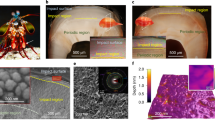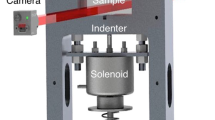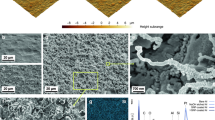Abstract
The structure of the stomatopod dactyl club—an ultrafast, hammer-like device used by the animal to shatter hard seashells—offers inspiration for impact-tolerant ceramics. Here, we present the micromechanical principles and related micromechanisms of deformation that impart the club with high impact tolerance. By using depth-sensing nanoindentation with spherical and sharp contact tips in combination with post-indentation residual stress mapping by Raman microspectroscopy, we show that the impact surface region of the dactyl club exhibits a quasi-plastic contact response associated with the interfacial sliding and rotation of fluorapatite nanorods, endowing the club with localized yielding. We also show that the subsurface layers exhibit strain hardening by microchannel densification, which provides additional dissipation of impact energy. Our findings suggest that the club’s macroscopic size is below the critical size above which Hertzian brittle cracks are nucleated.
This is a preview of subscription content, access via your institution
Access options
Subscribe to this journal
Receive 12 print issues and online access
$259.00 per year
only $21.58 per issue
Buy this article
- Purchase on Springer Link
- Instant access to full article PDF
Prices may be subject to local taxes which are calculated during checkout





Similar content being viewed by others
References
Chen, P. Y., McKittrick, J. & Meyers, M. A. Biological materials: Functional adaptations and bioinspired designs. Prog. Mater. Sci. 57, 1492–1704 (2012).
Amini, S. & Miserez, A. Wear and abrasion resistance selection maps of biological materials. Acta Biomater. 9, 7895–7907 (2013).
Barthelat, F. & Espinosa, H. D. An experimental investigation of deformation and fracture of nacre-mother of pearl. Exp. Mech. 47, 311–324 (2007).
Kamat, S., Su, X., Ballarini, R. & Heuer, A. H. Structural basis for the fracture toughness of the shell of the conch Strombus gigas. Nature 405, 1036–1040 (2000).
Li, L. & Ortiz, C. Pervasive nanoscale deformation twinning as a catalyst for efficient energy dissipation in a bioceramic armour. Nature Mater. 13, 501–507 (2014).
Bruet, B. J. B., Song, J., Boyce, M. C. & Ortiz, C. Materials design principles of ancient fish armour. Nature Mater. 748–756 (2008).
Yao, H. et al. Protection mechanisms of the iron-plated armor of a deep-sea hydrothermal vent gastropod. Proc. Natl Acad. Sci. USA 107, 987–992 (2010).
Munch, E. et al. Tough, bio-inspired hybrid materials. Science 322, 1516–1520 (2008).
Studart, A. Towards high-performance bioinspired composites. Adv. Mater. 24, 5024–5044 (2012).
Thoen, H. H., How, M. J., Chiou, T-H. & Marshall, J. A different form of color vision in Mantis shrimp. Science 343, 411–413 (2014).
Weaver, J. C. et al. The stomatopod dactyl club: A formidable damage-tolerant biological hammer. Science 336, 1275–1280 (2012).
Amini, S. et al. Textured fluorapatite bonded to calcium sulphate strengthen stomatopod raptorial appendages. Nature Commun. 5, 3187 (2014).
He, L. H., Fujisawa, N. & Swain, M. V. Elastic modulus and stress–strain response of human enamel by nanoindentation. Biomaterials 27, 4388–4398 (2006).
He, L. H. & Swain, M. V. Nanoindentation derived stress–strain properties of dental materials. Den. Mater. 23, 814–821 (2007).
Sachs, C., Fabritius, H. & Raabe, D. Influence of microstructure on deformation anisotropy of mineralized cuticle from the lobster Homarus americanus. J. Struct. Biol. 161, 120–132 (2008).
Lawn, B. Indentation of ceramics with spheres: A century after hertz. J. Am. Ceram. Soc. 81, 1977–1994 (1998).
Morris, D. J. & Cook, R. F. In situ cube-corner indentation of soda-lime glass and fused silica. J. Am. Ceram. Soc. 87, 1494–1501 (2004).
Miserez, A. et al. Effects of laminate architecture on fracture resistance of sponge biosilica: Lessons from Nature. Adv. Funct. Mater. 18, 1–8 (2008).
Schuh, C. A. Nanoindentation studies of materials. Mater. Today 9, 32–40 (2006).
Launey, M. E., Chen, P-Y. & Ritchie, R. O. Mechanistic aspects of the fracture toughness of elk antler bone. Acta Biomater. 6, 1505–1514 (2010).
Wang, R. & Gupta, H. S. Deformation and fracture mechanisms of bone and nacre. Annu. Rev. Mater. Res. 2011, 41–73 (2011).
Lawn, B. Fracture of Brittle Solids 2nd edn (Cambridge Univ. Press, 1993).
Wang, X., Padture, N. P. & Tanaka, H. Contact-damage-resistant ceramic/single-wall carbon nanotubes and ceramic/graphite composites. Nature Mater. 3, 539–544 (2004).
Zok, F. & Miserez, A. Property maps for abrasion resistance of materials. Acta Mater. 55, 6365–6371 (2007).
Rhee, Y-W., Kim, H-W., Deng, Y. & Lawn, B. R. Brittle fracture versus quasi plasticity in ceramics: A simple predictive index. J. Am. Ceram. Soc. 84, 561–565 (2001).
Deng, Y., Lawn, B. R. & Lloyd, I. K. Characterization of damage modes in dental ceramic bilayer structures. J. Biomed. Mater. Res. 63, 137–145 (2002).
Guiberteau, F., Padture, N. P. & Lawn, B. R. Effect of grain size on Hertzian contact damage in alumina. J. Am. Ceram. Soc. 77, 1825–1831 (1994).
Barthelat, F., Tang, H., Zavattieri, P. D., Li, C-M. & Espinosa, H. D. On the mechanics of mother-of-pearl: A key feature in the material hierarchical structure. J. Mech. Phys. Solids 55, 306–337 (2007).
Li, X., Xu, Z-H. & Wang, R. In situ observation of nanograin rotation and deformation in nacre. Nano Lett. 6, 2301–2304 (2006).
Meyers, M. A. Dynamic Behavior of Materials 323–381 (John Wiley, 1994).
Acknowledgements
This research is financially supported by the Singapore National Research Foundation (NRF) through a NRF Fellowship awarded to A.M. S.A. and M.T. are supported by a Singapore International Graduate Award (SINGA fellowship). We thank T. Baikie for providing the geologic FAP sample, A. Krishna for assistance with sample preparation, A. Serjouei and M. Qwamizadeh for advice on DFEA simulations, and A. Cohen for providing access to the microCT equipment.
Author information
Authors and Affiliations
Contributions
S.A. conducted all experiments and DFEA simulations, and performed all data analysis. M.T. helped conduct nanoindentation experiments, DFEA simulations, and Raman spectroscopy data analysis. S.I. advised on Hertzian indentation experiments, supervised DFEA simulations, and provided editorial comments. A.M. designed and supervised the study. A.M. and S.A. wrote the paper with input from all authors.
Corresponding author
Ethics declarations
Competing interests
The authors declare no competing financial interests.
Supplementary information
Supplementary Information
Supplementary Information (PDF 2899 kb)
Rights and permissions
About this article
Cite this article
Amini, S., Tadayon, M., Idapalapati, S. et al. The role of quasi-plasticity in the extreme contact damage tolerance of the stomatopod dactyl club. Nature Mater 14, 943–950 (2015). https://doi.org/10.1038/nmat4309
Received:
Accepted:
Published:
Issue Date:
DOI: https://doi.org/10.1038/nmat4309
This article is cited by
-
Fluid protein condensates for bio-inspired applications
Nature Reviews Bioengineering (2023)
-
Graphene oxide bulk material reinforced by heterophase platelets with multiscale interface crosslinking
Nature Materials (2022)
-
Mechanical properties, degree of sclerotisation and elemental composition of the gastric mill in the red swamp crayfish Procambarus clarkii (Decapoda, Crustacea)
Scientific Reports (2022)
-
Mechanically excellent nacre-inspired protective steel-concrete composite against hypervelocity impacts
Scientific Reports (2021)
-
Biomechanics of insect cuticle: an interdisciplinary experimental challenge
Applied Physics A (2021)



